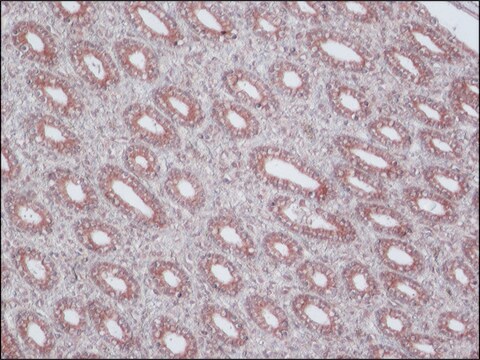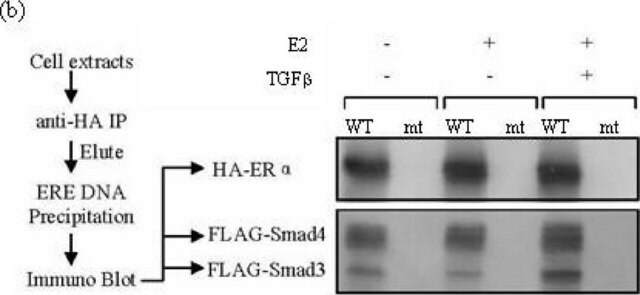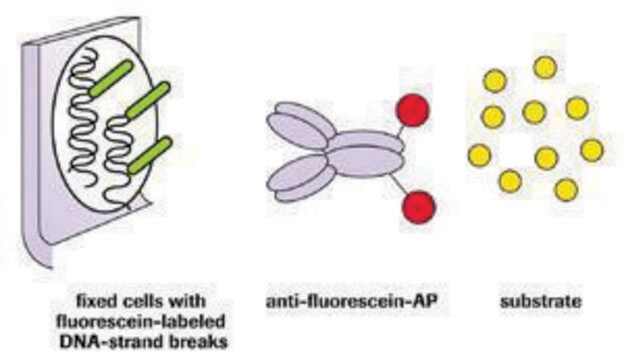P8538
Protein Kinase Cδ isozyme human
>95% (SDS-PAGE), recombinant, expressed in baculovirus infected insect cells, buffered aqueous glycerol solution
Sinônimo(s):
Ca2+-activated phospholipid-dependent serine-threonine kinase δ isozyme human, PKCδ human
Faça loginpara ver os preços organizacionais e de contrato
About This Item
Número MDL:
Código UNSPSC:
51111800
NACRES:
NA.32
Produtos recomendados
recombinante
expressed in baculovirus infected insect cells
Nível de qualidade
Ensaio
>95% (SDS-PAGE)
Formulário
buffered aqueous glycerol solution
peso molecular
74-79 kDa by SDS-PAGE
nº de adesão UniProt
Condições de expedição
dry ice
temperatura de armazenamento
−70°C
Informações sobre genes
human ... PRKCD(5580)
Ações bioquímicas/fisiológicas
Protein Kinase C (PKC) is a serine/threonine kinase that is activated intracellularly by signal transduction pathways that produce DAG from phosphatidylinositol diphosphate (PIP2) and phosphatidylcholine (PC) through the action of various activated phospholipases. Phorbol esters also stimulate PKC. At least 11 PKC isozymes have been identified that differ in primary structure, tissue distribution, subcellular localization, response to extracellular signals, and substrate specificity. The isozymes can be grouped into three subfamilies. Members of the first family require Ca2+ and phospholipid and include PKCα, βI, βII, and γ. Members of the second family are phospholipid-dependent but Ca2+-independent, and include PKCδ, ε, η, and θ. Members of the third family are not activated by either DAG or phorbol esters and include PKCξ, μ, and ι.
Phosphorylation appears to be an important mechanism of regulation of all PKCs. PKC plays a role in the regulation of cell transformation, growth, differentiation, ruffling, vesicle trafficking, apoptosis and gene expression.
Phosphorylation appears to be an important mechanism of regulation of all PKCs. PKC plays a role in the regulation of cell transformation, growth, differentiation, ruffling, vesicle trafficking, apoptosis and gene expression.
Definição da unidade
One unit will transfer 1 nmol of phosphate to PKC epsilon substrate peptide in 1 min at pH 7.4 at 30 °C.
forma física
Solution in 20 mM HEPES, pH 7.4; 2 mM EDTA, 2 mM EGTA, 5 mM DTT, 100 mM NaCl, 0.05% Triton X-100, and 50% glycerol.
Código de classe de armazenamento
10 - Combustible liquids
Classe de risco de água (WGK)
WGK 1
Ponto de fulgor (°F)
Not applicable
Ponto de fulgor (°C)
Not applicable
Equipamento de proteção individual
Eyeshields, Gloves, multi-purpose combination respirator cartridge (US)
Escolha uma das versões mais recentes:
Já possui este produto?
Encontre a documentação dos produtos que você adquiriu recentemente na biblioteca de documentos.
Hai Huang et al.
Development (Cambridge, England), 138(12), 2477-2485 (2011-05-13)
Post-translational modification by the small ubiquitin-related modifier (SUMO) is important for a variety of cellular and developmental processes. However, the precise mechanism(s) that connects sumoylation to specific developmental signaling pathways remains relatively less clear. Here, we show that Smt3 knockdown
Jun Hou et al.
Journal of thoracic oncology : official publication of the International Association for the Study of Lung Cancer, 7(1), 105-114 (2011-12-03)
A challenge of cancer therapy is to optimize therapeutical options to individual patients. Cancers with similar histology may show dramatically different responses to therapy, indicating that a refined approach needs to be developed to classify tumors by intrinsic characteristics that
Sung Chul Lee et al.
Proceedings of the National Academy of Sciences of the United States of America, 104(40), 15959-15964 (2007-09-28)
Potassium (K(+)) is an essential nutrient for plant growth and development. Plants often adapt to low K(+) conditions by increasing their K(+) uptake capability. Recent studies have led to the identification of a calcium signaling pathway that enables plants to
Yong Xiang et al.
Plant physiology, 144(3), 1416-1428 (2007-05-31)
Plants respond to adverse environments by initiating a series of signaling processes that often involves diverse protein kinases, including calcineurin B-like protein-interacting protein kinases (CIPKs). In this study, putative CIPK genes (OsCIPK01-OsCIPK30) in the rice (Oryza sativa) genome were surveyed
Cecilia D'Angelo et al.
The Plant journal : for cell and molecular biology, 48(6), 857-872 (2006-11-10)
Intracellular release of calcium ions belongs to the earliest events in cellular stress perception. The molecular mechanisms integrating signals from different environmental cues and translating them into an optimized response are largely unknown. We report here the functional characterization of
Nossa equipe de cientistas tem experiência em todas as áreas de pesquisa, incluindo Life Sciences, ciência de materiais, síntese química, cromatografia, química analítica e muitas outras.
Entre em contato com a assistência técnica







